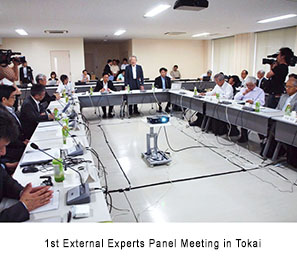| ¡@J-PARC News - June 2013 (Issue #98) |
| In the Hadron experimental hall (HD hall), the proton beam extracted from the 50 GeV Synchrotron (MR) is brought onto a gold target to produce secondary particles, such as K-mesons and experiments had been conducted with K-mesons since May 13. At around 11:55 of May 23, due to a malfunction of the beam extraction system of the MR, a proton beam was delivered to the gold target within a very short time (5/1000 of a second), whereas normally protons were slowly and evenly extracted and delivered to the target over a period of 2 seconds. As a result, the gold target is considered to have momentarily reached an extremely high temperature and possibly to have been partially damaged. Radioactive material then leaked into the HD hall.
Thirty-four workers (all are radiation registered workers) externally and/or internally exposed to radiation. The total (internal plus external) radiation doses were in the range of 0.1-1.7 mSv. Operation of ventilation fans of the HD hall resulted in the release of radioactive material out of the radiation controlled area of the Hadron Experimental Facility (HD Facility). It has been estimated that the maximum integrated radiation dose at the site boundary closest to the HD Facility was 0.29 μSv.
We deeply regret the following incidents including our inadequate responses, such as the leak of radioactive material into the HD hall, the release of the material out of the radiation controlled area of the HD Facility, a delay in reporting the incident to relevant authorities and local communities, the result of internal exposure of workers in the HD hall caused by inhalation of radioactive material, and delays in suspending the accelerator complex operation and stopping the ventilation operation. We would like to convey all our deepest apologies for any disruptions and concerns that have been caused by the radioactive material leak accident at the HD Facility. |
  |
 * Click here to enlarge. * Click here to enlarge. |
|
|
|
| Over the three days from June 13-15, meetings were held in Tokai to explain the radioactive material leak accident at the Hadron Experimental Facility. The J-PARC Center apologized for causing the accident, and provided a basic overview of what happened. After each presentation, there was a question and answer period, and we listened to comments from the public. All of the meetings ran over their scheduled time, and we listened carefully to what every single person had to say. A series of slides to explain the accident and summary of the questions asked in Japanese has been posted on the J-PARC homepage. |
  |
|
| Submissions of Reports on the radioactive material leak at the Hadron Experimental Facility (May 31 and June 18) |
| In accordance with Prevention of Radiation Health Impairment Due to Radioisotope, etc. and its enforcement ordinance, the High Energy Accelerator Research Organization (Director General: Atsuto Suzuki) and the Japan Atomic Energy Agency (President: Shojiro Matsuura) submitted the first report to the Nuclear Regulation Authority on May 31 and the second one on June 18. On the same days, we also submitted gthe accident reportsh on the same incident to Ibaraki Prefecture, Tokai Village, and other relevant local governments based on the agreement on safety and environmental protection near nuclear facilities.
These reports summarize the issues identified through our investigation so far and our analysis on them up to now. We will continue more detailed investigation toward the final report, which incorporates inputs we seek from external experts. |
| £to Page Top |
|
| An on-site inspection was conducted by the Secretariat of the Nuclear Regulation Authority. First, the overall situation of the accident was confirmed with the relevant staff from J-PARC. Then on-site checking and related tasks were carried out in chronological order together with persons involved at the time of the accident at the Hadron Experimental Facility. |
  |
|
| In response to the request by the Minister of Education, Culture, Sports, Science and Technology, KEK and JAEA set up the External Experts Panel on June 18. They will be asked to recheck items such as J-PARC's safety management system and procedures to be followed in case of an emergency. Six experts from a wide range of fields were appointed as members, and the first meeting was held on June 21 in Tokai. At the beginning of the meeting, Dr. Yasushige Yano was selected as the chair by mutual vote. The involved staff from J-PARC provided a basic overview of the accident, and the Central Control Room which supervises the operation of accelerators and the Hadron Experimental Facility where the accident occurred were closely inspected. After that, the meeting shifted to a discussion of the recent accident, and the team confirmed factual issues, and matters such as how to proceed with future meetings. |
   * Click here to enlarge. * Click here to enlarge. |
|
Copyright 2011 JAEA and KEK Joint Project. All rights reserved.
|
|